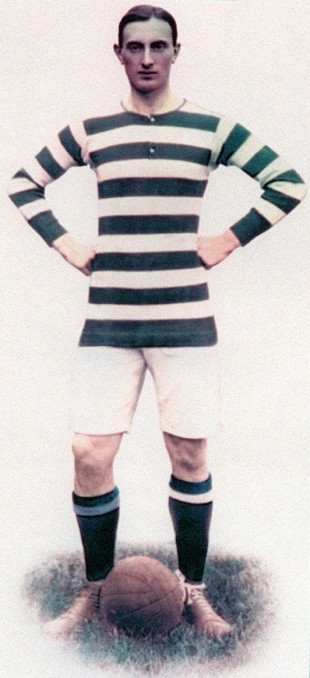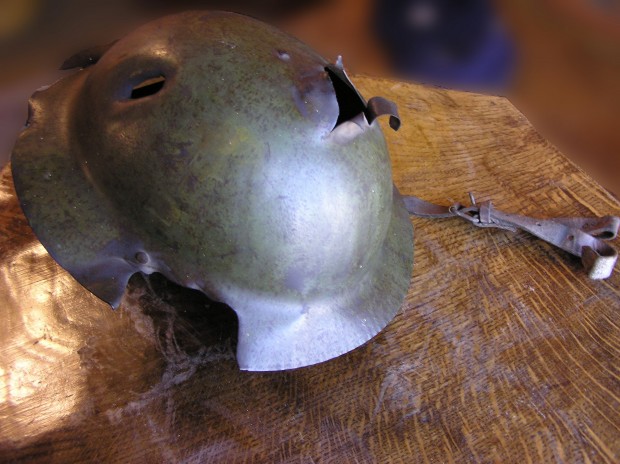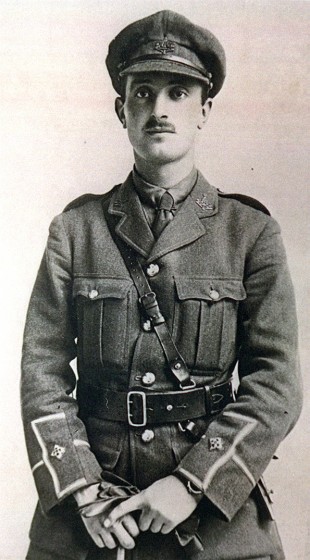
ENLISTED PLAYER: Donald Bell, full back for Bradford Park Avenue, was the first professional footballer to enlist
“I must confess that it was the biggest fluke alive and I did nothing, ” Second Lieutenant Donald Bell of the Green Howards wrote home on July 7, 1916.
“I only chucked one bomb, but it did the trick. The C.C. says I saved the situation for this gun was doing all the damage.”
A year earlier, Second Lieutenant “Donny” Bell had become the first professional footballer to give up the day job kicking around a pig’s bladder and enlist to fight in the Great War, and in his letter home he was describing the action in which he became the first English professional footballer to win the Victoria Cross.
His sporting prowess may even have helped – he was also a useful cricketer and he used his overarm bowling action to lob grenades at the enemy with lethal accuracy.
“I am glad I have been so fortunate for Pa’s sake, for I know he likes his lads to be at the top of the tree, ” he wrote.
“He used to be always on about too much play and too little work, but my athletics came in handy this trip. The only thing is I am sore at the elbows and knees with crawling over limestone flints.”
Memories 86 said that Bell’s story “deserves to be better known” and we are delighted to say that his Victoria Cross has just gone on display at the National Football Museum, which opened in Manchester last weekend.
The tragedy of Bell’s story is that three days after putting pen to paper in the trenches of the Somme to tell the folks at home of his news, the 26-yearold footballer was killed.
You can still see how a German bullet opened his metal helmet like a tin can because the helmet is on display in the Green Howards museum in Richmond, the town which is the regiment’s spiritual home and where the pain of its removal last week from the Order of Battle was most keenly felt.

The helmet that footballer Donald Bell was wearing when he was killed in July 1916 is now in the Green Howards Museum, in Richmond
Donny Bell was born in Harrogate. He went to school in Knaresborough, where he excelled at all sports, before training as a teacher in Westminster. In 1911, he qualified, got a job back in Harrogate, and augmented his chalkface wage by turning out for boot money for Bishop Auckland and then Newcastle United.
In 1912, Second Division Bradford Park Avenue offered him more boot money than the First DivisionMagpies – £2 10s a week – and they were closer to home to boot, so he turned out for them.
At the start of the 1913-14 season, he gave up teaching and turned pro. A strapping defender with a surprising turn of pace, he assisted Bradford in gaining promotion to the top league where he would play against the best players of the day.
But before the 1914-15 season kicked off, Bell wrote to his manager saying: “I have now come to the conclusion I am duty bound to join the ranks.Will you therefore kindly ask the directors of Bradford Football Club to release me from my engagement?”
Rather than face the three North-East clubs in the First Division, plus Manchester United, Liverpool and Chelsea, Bell chose to face the German enemy.
He left with the Green Howards for France in August 1915, returning home briefly to get married in June 1916, before returning to the Battle of the Somme.

TRUE HERO: Second Lieutenant Donald Bell in his Green Howards uniform
On July 5, at Horseshoe Trench, near the village of Contalmaison, he used his footballer’s speed to dash across no man’s land under heavy fire and his cricketer’s accuracy to put an enemy machine gun out of action with Mills bombs.
In that last letter home, he was very modest. “There is talk of me getting a military cross or something of the sort, ” he wrote. “Talk about luck! Fancy, just chucking one’s bombs, even if it was a bull’s eye.”
In fact, for this brave fluke he was awarded the Victoria Cross – sadly, it was a posthumous award as on July 10 he was killed leading a bombing party that drove off a German counter-attack.
“He is not entirely forgotten, ” says Sheila Dixon in Barnard Castle.
“I took a picture of his memorial at Bell’s Redoubt, where he fell, last summer while on a family trip. It’s in the village of Contalmaison, near Mametz Wood, at the southern end of the Somme, and is about a kilometre west of Horseshoe Trench where he won his VC.
“The memorial is by the Professional Footballers’ Association and the Friends of the Green Howards, and was unveiled in July 2000 by Major General Richard Dannatt of the regiment.
“It is well tended, and is in what is now a very peaceful spot where it forms a moving tribute to a brave man.”
As we said in Memories 86, 2nd Lt Bell’s story is told in the newlypublished Yorkshire VCs by Alan Whitworth (Pen & Sword). Bell was the first professional footballer to enlist, but Alex Jackson, who researched the display on him at the new National Football Museum, cautions: “In regards to him being the first footballing VC, I’d be careful about this as William Angus won a VC in 1915. He had been with Celtic in 1914 before signing for Wishaw Thistle, a Scottish Junior league team.”





